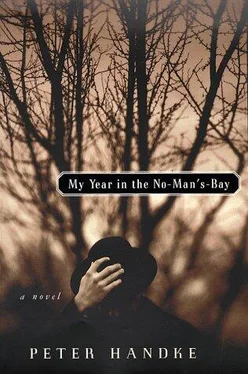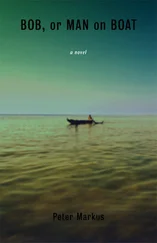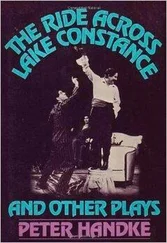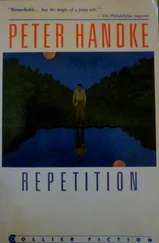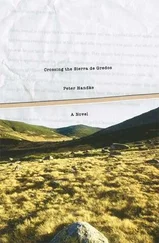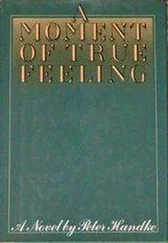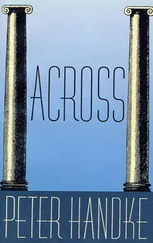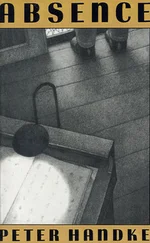So was it still possible, now near the end of the twentieth century, to be motivated and stimulated, as once in the age of the great engineers, by a machine, the sight of it, its sound, its speed, undeterred even by the thought of a catastrophe right around the next corner?
Was he still “the painter”? (He allowed himself to be called a “filmmaker” or “cinéaste,” despite his film, long since finished and even shown here and there, only with a modest step to one side, as if to make way for someone else.)
He had begun to paint long ago with a particular notion of distance, which, however, did not then become a feature of his paintings. The distance was there beforehand: his original image — the thing that motivated him — his starting point. It determined him.
And now, as a result of his one role change to filmmaking? as a result of all that went with and came after it? as a result of what? he had lost that distance, his material? Once and for all? So what had this strange phenomenon, about which he had found nothing, not even in the textbook on “psychogeometry,” meant to him in the past?
That distance had appeared to him way back in childhood as the blackness he saw when he closed his eyes.
Yet since birth he had fixed his gaze on the most distant horizon possible: from Tarragona in the direction of the sunrise, out over the Mediterranean, overlooking which, people said, the city lay as a “balcony.” The sense of distance he got from this was, however, one of apprehension, in the face of the emptiness and the height, and the infrequent ships or boats in the middle distance did not suggest safety. The inky or steely or leaden blue also contributed to his impression that in this boundlessness there was no destination, or, if there was, then over in ancient Rome, where, he was sure, one of his ancestors who had been dragged away from his coast had ended his life as a slave or as lion fodder.
With eyes closed, he saw an entirely different distance. In all the blackness something like a harbor took shape, where he saw himself safely anchored.
And it was even more: in the black expanse, which did not seem all that black, but shot through with thousands of variegated little brigh-tenings, without movement, something was constantly being danced, played, sung, narrated, drawn, as a model for him. “Model for,” for it was not a question of images copied “from” anything. Besides, copies consisted only of foreground, and moved, vibrated, shrank, grew, as if on their own, while his stories in the blackness took place in the most distant background possible, and the movement he perceived in them seemed to come from him himself — from his heartbeat? no, for that it was too light, too disembodied — from his lungs? for that it was too quick — from his brain? for that it was too even, too powerful in imagery, too comprehensive, too intimate, too childlike.
It was even stranger that closing his eyes, without crossing them in the least, he could look away from the distant black happenings and then continue to watch them, except that the distance now shifted from its place behind his closed lids into his innermost self and became something whole, “one and all.”
To be sure, that happened during his childhood only when he was lying in bed, as he was waking up in the morning. So were they images between waking and sleeping? No, neither copied images nor images between waking and sleeping. For the distance behind his eyes, he had to have had a good sleep and be well beyond the boundary of dreams, clearheaded, and the distance also did not create concrete images, as the state between waking and sleeping created still lives, for instance, especially of landscapes, and it also dispensed with the succession of spaces characteristic of that other state, indeed with space altogether; the distance itself was enough. And nevertheless it was active, and what it did was to produce an effect. Produce what effect? This constant, marvelously delicate movement in him and at the same time independent of him, without beginning or end, a sort of motionlessly moving repeated figure in the blackness, drawn to guide him.
And then with the years, he could say, paraphrasing Paul Klee, “The distance and I are one, I am a painter.”
Yet it was something else again to get down to the images and get down to work. That was where painting began, art. It was not reproduction that counted but metamorphosis, or reproduction through metamorphosis. The starting point disappeared into it, or was absorbed into it. What was drawn for him, his model, formed only the bottom layer, and with scraping would perhaps have actually come to light sometimes, the mere appearance standing in baffling contradiction to the completed picture. For this he not only had to displace the original image, set it on its head, but also, so far as it was within his strength, invent things to add as well as subtract, so that as a rule something entirely new emerged in the end.
Precisely through such energetic distortions he could then, with reference to the distance, say of each picture: “I have reinforced a presence.” And it had been a long time since the painter experienced his source of motivation only with eyes closed, when lying down. And on the other hand, he still found nothing in just any old distant blue, or red, or yellow. The location of his particular distance was somewhere nearer, could shimmer out at him from a clump of earth, mixed with stones and wood, at the tips of his toes, or when the colors of someone’s eyes transmitted themselves to him from close up, also, in the mirror, his own (Black Sea black).
This distance could be most reliably tracked down, at least before his involvement with film, in a very specific visual realm.
That realm began at a certain remove from the eye, and yet long before what is commonly referred to as distance. The path leading to it was difficult to measure; earlier people would have said, for instance, “a stone’s throw” (how large was such a stone, and who was throwing it?). And then the sense of distance was limited to a rather narrow strip or spot; if he looked out past it, just a bit, that promptly put an end to the distance, even if the high sea spread before him or the grassy lane swept into a savanna.
Thus distance appeared, just begging to be circumscribed and conveyed to the surface of a picture, at the end of a garden, for instance, in front of that wall and the bushes over there, on the ground, in the grass. It revealed itself thus on a pond in the forest, just before the barway on the opposite bank, as a delimited place there on the water, almost no more than a little tip.
And curious, too, that an ordinary meadow was already too spacious for such a unit of distance, while an ordinary backyard was too small. And the same was true of a lake on the one hand and of a mere puddle on the other. To offer material for an image of distance, the yard had to be larger than usual, just as the pond had to extend farther than a pond usually does — both, however, by just a bit, “to be recognized,” “by a factor of one.” And that, to be precise, was the measure of distance.
Only in this way did distance seeing come into being, as was fitting for a law of nature.
At the same time a displacement occurred such as no other distant horizon could bring about, neither that of the Himalayas nor of the Amazon delta: as a result of its limitation or framing, this particular distance drew the painter into a scenery, with a light on the water, on the grass, on the treetops like that in a mirror, and distance literally put in an appearance: there! It will start right there, there is the place to board, it will take place there, it will play itself out there, it will be hatched there, it will become concentrated there, it will catch fire there, it will be spread out there, right over there, in that narrow, limited patch of distance it is clear again, everything is being freshly polished, is gleaming as on the first day of the Creation.
Читать дальше
